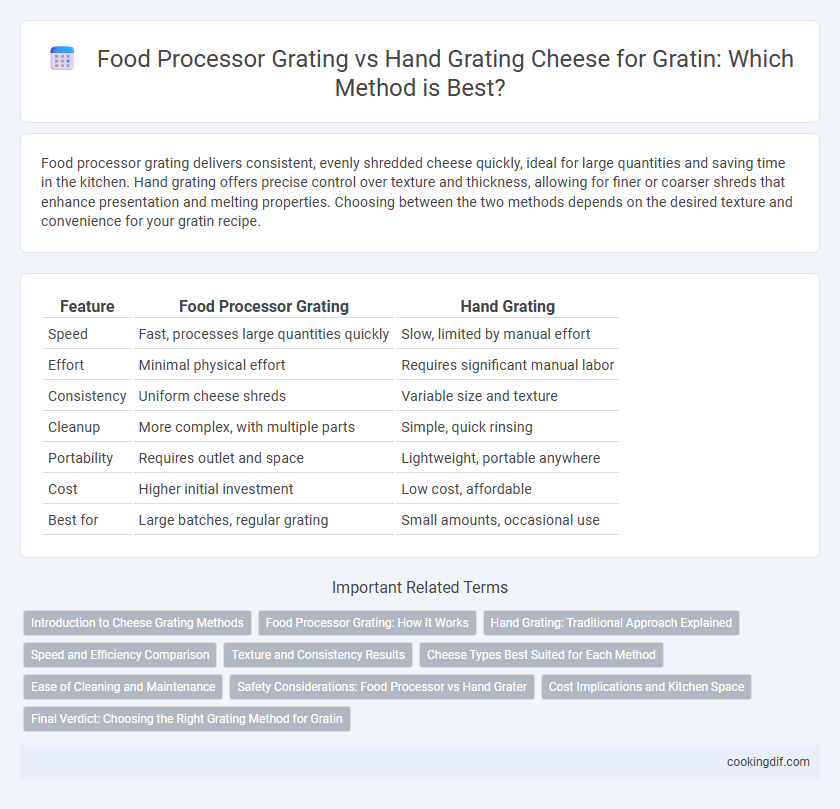Food processor grating delivers consistent, evenly shredded cheese quickly, ideal for large quantities and saving time in the kitchen. Hand grating offers precise control over texture and thickness, allowing for finer or coarser shreds that enhance presentation and melting properties. Choosing between the two methods depends on the desired texture and convenience for your gratin recipe.
Table of Comparison
| Feature | Food Processor Grating | Hand Grating |
|---|---|---|
| Speed | Fast, processes large quantities quickly | Slow, limited by manual effort |
| Effort | Minimal physical effort | Requires significant manual labor |
| Consistency | Uniform cheese shreds | Variable size and texture |
| Cleanup | More complex, with multiple parts | Simple, quick rinsing |
| Portability | Requires outlet and space | Lightweight, portable anywhere |
| Cost | Higher initial investment | Low cost, affordable |
| Best for | Large batches, regular grating | Small amounts, occasional use |
Introduction to Cheese Grating Methods
Cheese grating methods vary significantly between food processors and hand graters, each offering distinct advantages tailored to culinary needs. Food processors provide rapid, consistent grating ideal for large quantities of cheese like Parmesan or cheddar, optimizing preparation time in busy kitchen environments. Hand grating, using tools such as microplanes or box graters, allows for greater control over texture and fineness, enhancing presentation and flavor release in dishes requiring delicate cheese finishes.
Food Processor Grating: How It Works
Food processor grating uses a sharp, rotating stainless steel blade to quickly shred cheese into uniform pieces, significantly reducing preparation time compared to hand grating. Its motorized mechanism ensures consistent texture and size, ideal for recipes requiring finely grated cheese like gratins. This method minimizes physical effort and prevents hand fatigue while delivering precise results ideal for culinary precision.
Hand Grating: Traditional Approach Explained
Hand grating cheese offers precise control over texture and thickness, essential for achieving the perfect melt in gratins. Traditional hand graters create varied, rustic cheese shreds that blend seamlessly with layered potatoes and cream, enhancing both flavor and presentation. Unlike food processors, hand grating preserves the cheese's integrity without generating heat, preventing premature melting and preserving freshness.
Speed and Efficiency Comparison
Food processors grate cheese significantly faster than hand graters, processing large quantities in seconds with consistent results. Hand grating allows for more control over shred thickness but is slower and requires more physical effort, making it less efficient for bulk tasks. Choosing a food processor enhances productivity in kitchens where speed and uniformity are crucial.
Texture and Consistency Results
Food processor grating produces uniformly sized cheese pieces with a consistent texture, ideal for even melting in dishes like gratins. Hand grating yields more variable shreds, offering a coarser texture that can create pockets of melted cheese and a slightly rustic appearance. Choosing between the methods depends on the desired final dish texture and presentation, with food processors providing efficiency and uniformity, while hand grating allows for nuanced texture variation.
Cheese Types Best Suited for Each Method
Hard cheeses like Parmesan and Pecorino are best grated using a food processor, ensuring uniform shreds and saving time on large quantities. Softer cheeses such as mozzarella, cheddar, and Swiss benefit from hand grating, which offers better control and prevents clumping or excessive melting. The food processor's blade efficiency suits dense, aged cheeses, whereas delicate, fresh varieties respond well to manual grating for optimal texture.
Ease of Cleaning and Maintenance
Food processor grating offers quick disassembly and dishwasher-safe parts, simplifying cleaning and reducing maintenance time. Hand graters require manual scrubbing and careful handling to avoid clogging and rust, making them more labor-intensive to maintain. Choosing a food processor grater enhances hygiene and durability through efficient cleaning processes.
Safety Considerations: Food Processor vs Hand Grater
Food processors provide enhanced safety for grating cheese by reducing direct hand contact with sharp blades, significantly lowering the risk of cuts compared to hand graters. Hand grating requires careful finger positioning and attention to avoid injury, especially with hard cheeses. Using a food processor can streamline the grating process while minimizing safety hazards commonly associated with manual grating techniques.
Cost Implications and Kitchen Space
Using a food processor for grating cheese reduces manual effort and speeds up preparation, but it involves a higher upfront cost and requires significant kitchen counter or storage space. Hand grating remains more cost-effective, with minimal storage needs, making it ideal for small kitchens or occasional use. Choosing between the two depends on balancing budget constraints and available kitchen space against frequency and volume of cheese grating.
Final Verdict: Choosing the Right Grating Method for Gratin
Food processor grating offers uniform, finely shredded cheese that melts evenly, enhancing the creamy texture essential in a gratin. Hand grating allows for more control over cheese size, creating varied textures that add a rustic, artisanal touch to the dish. Selecting the right method depends on whether a smooth, consistent melt or a textured, handcrafted finish is preferred for your gratin.
Food processor grating vs Hand grating for cheese Infographic

 cookingdif.com
cookingdif.com